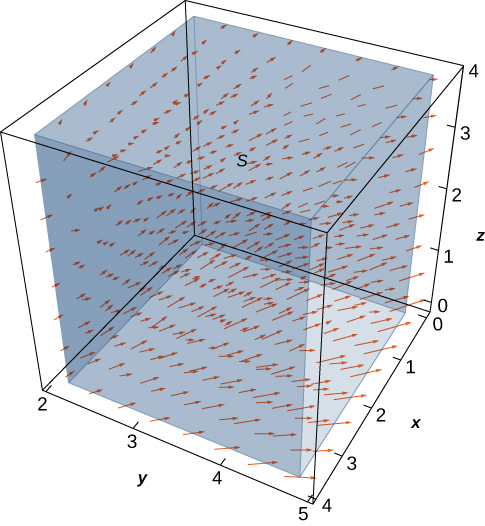| << Chapter < Page | Chapter >> Page > |
Let be the velocity field of a fluid. Let C be the solid cube given by and let S be the boundary of this cube (see the following figure). Find the flow rate of the fluid across S .

[link] illustrates a remarkable consequence of the divergence theorem. Let S be a piecewise, smooth closed surface and let F be a vector field defined on an open region containing the surface enclosed by S . If F has the form then the divergence of F is zero. By the divergence theorem, the flux of F across S is also zero. This makes certain flux integrals incredibly easy to calculate. For example, suppose we wanted to calculate the flux integral where S is a cube and
Calculating the flux integral directly would be difficult, if not impossible, using techniques we studied previously. At the very least, we would have to break the flux integral into six integrals, one for each face of the cube. But, because the divergence of this field is zero, the divergence theorem immediately shows that the flux integral is zero.
We can now use the divergence theorem to justify the physical interpretation of divergence that we discussed earlier. Recall that if F is a continuous three-dimensional vector field and P is a point in the domain of F , then the divergence of F at P is a measure of the “outflowing-ness” of F at P . If F represents the velocity field of a fluid, then the divergence of F at P is a measure of the net flow rate out of point P (the flow of fluid out of P less the flow of fluid in to P ). To see how the divergence theorem justifies this interpretation, let be a ball of very small radius r with center P , and assume that is in the domain of F . Furthermore, assume that has a positive, outward orientation. Since the radius of is small and F is continuous, the divergence of F is approximately constant on That is, if is any point in then Let denote the boundary sphere of We can approximate the flux across using the divergence theorem as follows:
As we shrink the radius r to zero via a limit, the quantity gets arbitrarily close to the flux. Therefore,
and we can consider the divergence at P as measuring the net rate of outward flux per unit volume at P . Since “outflowing-ness” is an informal term for the net rate of outward flux per unit volume, we have justified the physical interpretation of divergence we discussed earlier, and we have used the divergence theorem to give this justification.
The divergence theorem has many applications in physics and engineering. It allows us to write many physical laws in both an integral form and a differential form (in much the same way that Stokes’ theorem allowed us to translate between an integral and differential form of Faraday’s law). Areas of study such as fluid dynamics, electromagnetism, and quantum mechanics have equations that describe the conservation of mass, momentum, or energy, and the divergence theorem allows us to give these equations in both integral and differential forms.

Notification Switch
Would you like to follow the 'Calculus volume 3' conversation and receive update notifications?